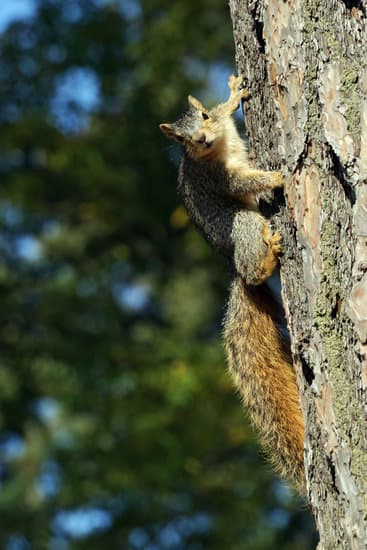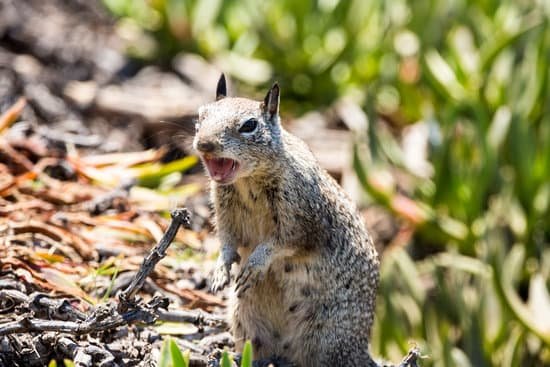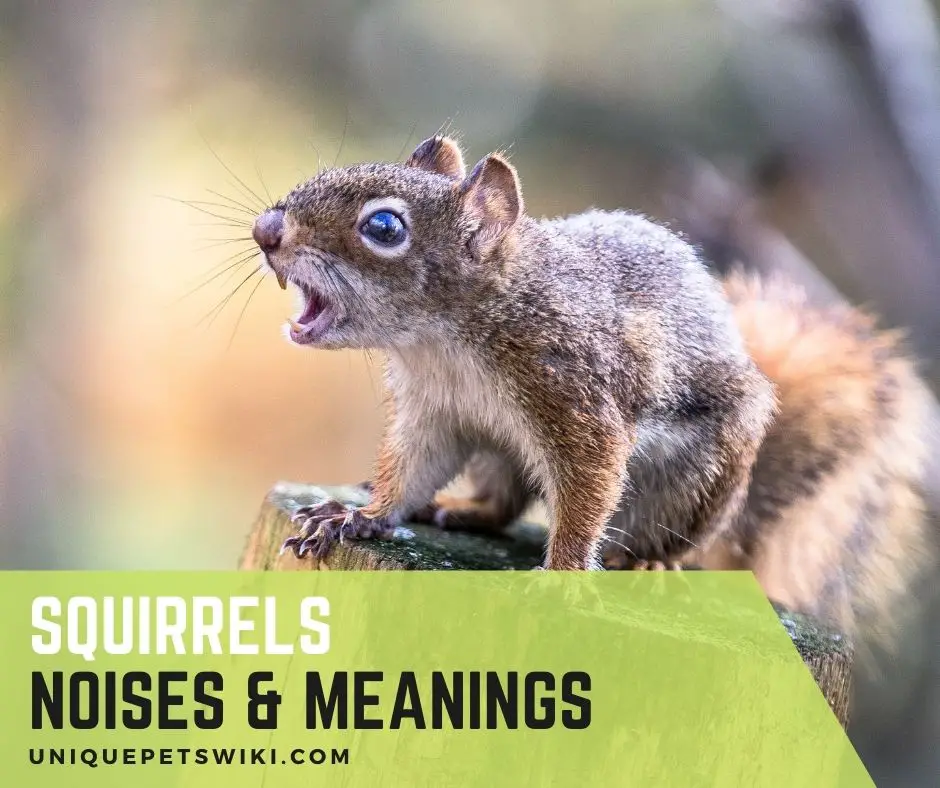Animals make sounds for various reasons, including attracting a mate, keeping off strangers from their territories, or even expressing pain, etc.
You might want to know what sounds squirrels make and also what that means when squirrels make noises.
Understanding animals’ noises is paramount, especially when handling them, and squirrels are no exception.
Squirrels are highly intelligent rodents and express a complex language system.
Further in the article, you will learn the different sounds that squirrels make and their meaning, and other relevant information.
This article has been reviewed by Dr. Linda. Read more about our knowledge control process here.
Contents
What Sounds Do Squirrels Make?

We hear animals making sounds, especially when near a forest, but sometimes the sound is very new, and we don’t know the animals we are listening to. Talking of squirrels, these lovely critters also have a variety of sounds.
We have about 200 squirrels’ species that are well known, and they make various sounds. Some common squirrel sounds are muk-muk, rattles, buzz, barking, seet, quaa, seet-bark, screeching, kuk-kuk-kuk, crying, high-pitched chirp.
Those are the sounds squirrels make, and each sound communicates a specific message. It’s not surprising to hear that squirrels can communicate with each other.
The intensity of the noise that squirrels make is different from one species to another. While some species appear to be more vocal, others will be less so. That means that a specific squirrel species has its own identifiable set of sounds.
Now that we have a list of sounds made by squirrels, you might also want to know what these sounds mean, as each sound has a different meaning.
But before that, always remember that the type and volume of sound squirrels make, primarily depends on gender, age, and circumstance. Having that in mind, let’s revisit each sound and learn its meaning.
Squirrels Sounds and Their Meanings
It’s clear now that squirrels make more than two noises, and each sound has a different meaning.
So, what are these meanings? Check them in the table below. We will also discuss them later in detail.

Squirrel Sounds and Meanings
| Sound | Meaning |
| Muk-muk | They are made by young squirrels and adults when mating. |
| Crying | Made by young squirrels |
| Buzz | Alarm call |
| High-pitched chirp | Young calling for mother |
| Seet | Terrestrial predator |
| Rattles | Defending territory |
| Barking | Alarm call |
| Seet-bark | Aerial predator |
| Quaa | Warning sound |
| Screeching | Defending territory |
| Kuk-kuk-kuk | Warning sound. |
As we all know, squirrels are territorial animals and will not tolerate any stranger approaching their territory.
This can be human beings, animals, or other squirrels.
That’s how protective they can be, and you will hear them rattling or screeching.
Don’t stop there yet; continue reading and dig deep into the meaning of all the sounds you hear squirrels making.
Sound #1: Muk-muk Sound
Muk-muk sound is common among young squirrels and also adults when mating.
We barely hear baby squirrels’ noises because their tones tend to be soft and subtle.
That way, the babies rarely attract the attention of predators.
Young squirrels make the muk-muk sound when hungry, thus alerting the mother that they need food. Muk-muk is a soft and puffy sound. Such sound is also common when squirrels are mating.
It’s the males that use the muk-muk sound to signal to a female squirrel on heat. Mating is characterized by a chasing behavior where a male chases after a female squirrel.
In the process, the male makes a muk-muk sound to reassure the female that he is not a threat. Muk-muk is like a stifled sneeze: phffft phffft.
Source: The Washington Post magazine.
Sound #2: Rattle Sound
Many wild animals will not tolerate an intruder into their territory, and this also applies to squirrels. In case a stranger oversteps into the squirrel’s boundary, these animals must sound a warning.
The warning is made up of a rattling sound to indicate that the squirrel is angry and you need to stay away. As an intruder, if you hear this sound, know that the squirrel wants you to recognize its presence.
A squirrel will also respond with a rattling sound when an intruder squirrel is present in its boundary. These animals have middens. These are places located within the territory where squirrels store food, and they usually defend them.
They warn the potential intruders to the middens with rattles. Rattle sound largely advertises the defending squirrel’s presence.
Sound #3: Crying Noise
The squirrel’s crying noise tends to communicate several different messages. For instance, if a squirrel spots a predator, it makes the crying noise and alerts others.
Moreover, these rodents also utter a crying sound in case of any injuries. You will also hear the crying sound when squirrels fight over food.
Furthermore, baby squirrels also tend to utter a low cry in two circumstances. The first one is when they feel startled and are calling out for their mother. The noise is pretty low such that the mother can only perceive it when nearby.
Baby squirrels cry when hungry. This is how they call out their mother to come and feed them.
Sound #4: Screeching
Squirrels emit screeching sounds to defend their territories. Screeches are different from rattles as the former one imparts a threat to the intruding squirrel wanting it to leave the area.
The squirrel is trying to communicate to the intruder that it sees it. In return, the intruder will know that it has lost its advantage and there is no alternative except to disappear.
Sound #5: High Pitched Chirp
Squirrels produce a high-pitched chirp sound when they communicate with each other. It happens mostly among the baby squirrels calling out parents in case of danger.
However, this is common noise among squirrels when they spot an aerial predator, such as hawks, owls, or eagles. You can hardly locate this sound from squirrels; thus, it’s a safe way for these animals to sound the alarm.
In such a situation, squirrels stay hiding from a predator that can follow them, and they appear very troubled. You can see them plastering against objects like trees and remain still.
Sound #6: Kuk-kuk-kuk
Kukking is a sharp bark of alarm, and it occurs in series. A squirrel may produce this sound directing it to fellow squirrels or predators.
A squirrel, sensing danger or the presence of a predator, signals out the sound to others, informing them of a predator’s presence nearby. Here, the audience is fellow squirrels.
Kuk sound plays double tasks. Ideally, a squirrel Kukking means it’s seeing a predator and is warning it from coming closer. Hence, predators are the second audience to kuk noise.
This sound has a short duration and a broad frequency when subjected to a spectrogram. A squirrel may or may not see its Kukking counterpart, but it can quickly locate the source of the sound.
When Kukking, squirrels orient themselves towards the threat; hence, their counterparts will know where the danger is.
Sound #7: Quaa
Quaa is among the warning calls that squirrels make. It is a long kuk that squirrels send out when the threat level drops.
For instance, a predator who realizes squirrels have spotted it will not remain in the area and leave. Quaa sound explains that squirrels can still see the predator, although it might be moving away.
Therefore, quaa follows after a kuk sound, and it has a lower intensity. It is basically a kuk that lasts for more than 0.15 seconds.
Sound #8: Seet, Barks, and Seet-barks
Seet sounds tend to have a high frequency and low amplitude. On the other hand, barks are simply loud alarm calls and tend to have a broad overtone. Seet-barks is a sound that is intermediate between seet and barks.
These sounds are common with North American red squirrels, and they are emitted to mean something. For example, squirrels emit seet and seet-barks in response to aerial predators like ravens.
Barks respond to animals like dogs and humans, which are terrestrial predators. Seet and seet-barks are used in combination, where the seet starts and is followed by a loud bark.
Sound #9: Buzz
Buzzes carry low amplitude and are common among Eastern grey squirrels. Buzzes tend to be inaudible, but you can hear them when you’re not far from squirrels making the noise.
Buzz sound has low intensity, and it resembles a quick sound uttered through the nostrils. These sounds also warn any predator approaching a squirrel’s territory.
Do Baby Squirrels Make Noises?
Yes, baby squirrels do make noises. By the third day of their lives, baby squirrels can make a minute squeak sound.
Although it is very seldom to see baby squirrels unless that which falls from the nest accidentally. We know that these young cuties are around through the sound they make.
A hungry baby squirrel will call out its mom by making a “muk-muk” sound. Once they reach one month old, you can hear them making short screams.
You might wonder how one can know it’s a baby squirrel making noise and not an adult. But it’s very possible to distinguish between the two. How is that?
Mature squirrel’s sound is loud, but their babies’ sound is relatively faint when they squeak and cry. If you are privileged to raise both the baby and adult squirrels, differentiating their sound is easy.
Likewise, to adults, baby squirrels’ sounds tend to differ depending on their intentions and age. We will see that below.
How Old are Baby Squirrels When They Make Noise?
Baby squirrels are easily recognized because of their soft, high-pitched chirping, unlike noisy adults. However, their sound is so subtle that you can barely hear them. That’s an advantage to these cuties since the room to attract the attention of predators is very minimal.
Back to the big question; how old are baby squirrels when they make noise? Our littlest rodents here produce distinct sounds that vary depending on age.
Newborn squirrels are likely not to make any noise; however, their vocals progress quickly with age. For instance, on day three of life, the baby can produce a minute squeak sound.
At around three weeks old, things will be different. At this point, the babies can growl to their mother wanting to be fed. And by the time they reach one month old, you can hear them making short screams.
Why Do Baby Squirrels Scream?
Why do baby squirrels scream is more or less the same as the distinct sounds from baby squirrels and their specific intentions?
A hungry baby squirrel will want nothing but to eat. The baby calls out its mum with a soft and puffy, ‘muk-muk’ sound in such a circumstance. The startled babies tend to make shrill cries. The cries are high-pitched and capable of reaching the mother.
Moreover, crying is not something new to baby squirrels. They cry in case of pain or danger and want the mother’s intervention.
Why Do You Never See a Baby Squirrel?
A mother squirrel cares for her babies for 70 days with no one seeing these little ones. The reason newborn squirrels don’t leave the nest is that they are born deaf and blind.
Additionally, these newborns are hairless until up to around five days, when the fur starts developing. Their fingers also tend to be joined. The mother nurtures them until they are fully furred and can survive independently.
All these reasons explain why baby squirrels initially spend a lot of their time in the nest under the mother’s protection.
Squirrels Crying Sound
A squirrel’s crying sound creates a lot of concern for squirrel lovers. These animals sound so sad when crying.
You don’t need to be an owner to pity these animals; once we love them, there is a profound connection. If a crying squirrel breaks your heart, know that you aren’t alone.
The crying noise of an animal is associated with anguish. Does this also reflect a crying squirrel? Of course, squirrels are no exception from the animal kingdom, indicating that they also cry when hurt.
Mature Squirrels Crying Sound
Crying sounds are common among baby squirrels when summoning their mother, but adult squirrels also cry and make crying sounds in various circumstances. For instance, a mature squirrel will cry when in distress, threat, trouble, struggle, etc.
A squirrel will cry when under attack or is pounced and wounded by a predator wnating to be saved.
Moreover, a squirrel won’t give itself up to predators. There will be a struggle as the squirrel is trying to save itself. In the process, the victim squirrel cries out to alert other squirrels of the danger.
So, don’t think that humans are the only ones who shout in the presence of danger; squirrels do too. Who would continue standing in a place where they know the outcome is death? It is neither humans nor animals.
Baby Squirrels Crying Sound
Children and crying go hand in hand. The same is true for baby squirrels. A baby squirrel crying is even more heartbreaking as they make a sad sound. What makes these littlest cuties so sad until they cry? You may wonder!
But baby squirrel crying is triggered by obvious things. For example, the babies tend to cry to summon their mum. They also make a crying sound when hungry, in danger, or due to pain and want care.
A squirrel’s sound is not meaningless. These animals are prone to attack by predators, and since they’re not very defendable, their crying sounds make them aware of each other’s danger.
Wrapping Up
It’s not new to us that squirrels have several sounds, and the type and intensity of the noise vary depending on the species.
Squirrel noises meaning are also different depending on their age, circumstance, and gender.
These creatures’ vocal sounds help them communicate with each other or portray a message to the potential predators.
The response towards the presence of predators alerts other squirrels there is a threat.
Squirrels are defenseless against a couple of predators, including dogs, ravens, humans, hawks, etc. Vocalizations help them to team up against their predators.
The range of vocal sounds is important to these cute rodents and is an essential mechanism to help them survive for many years in the wild.
